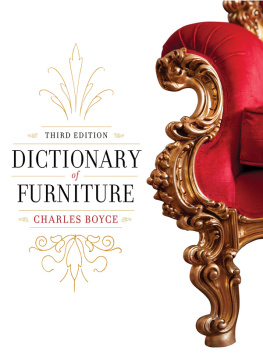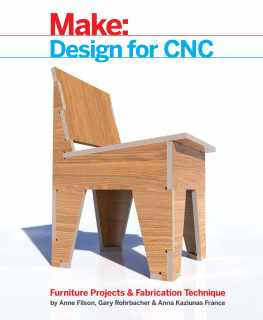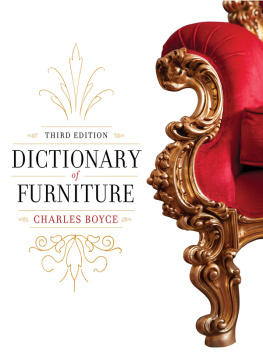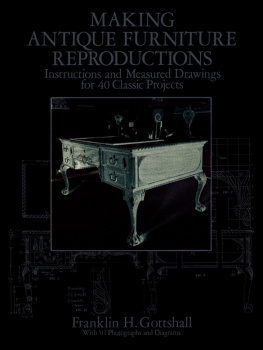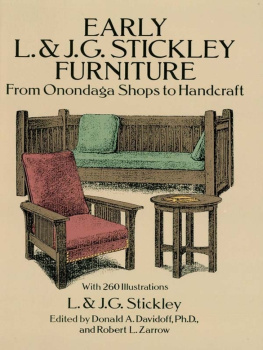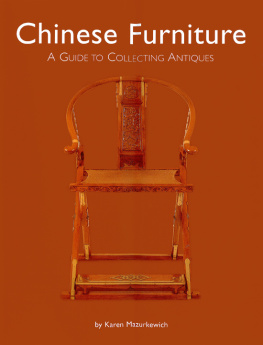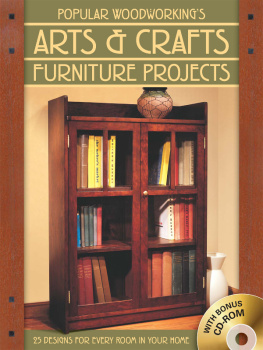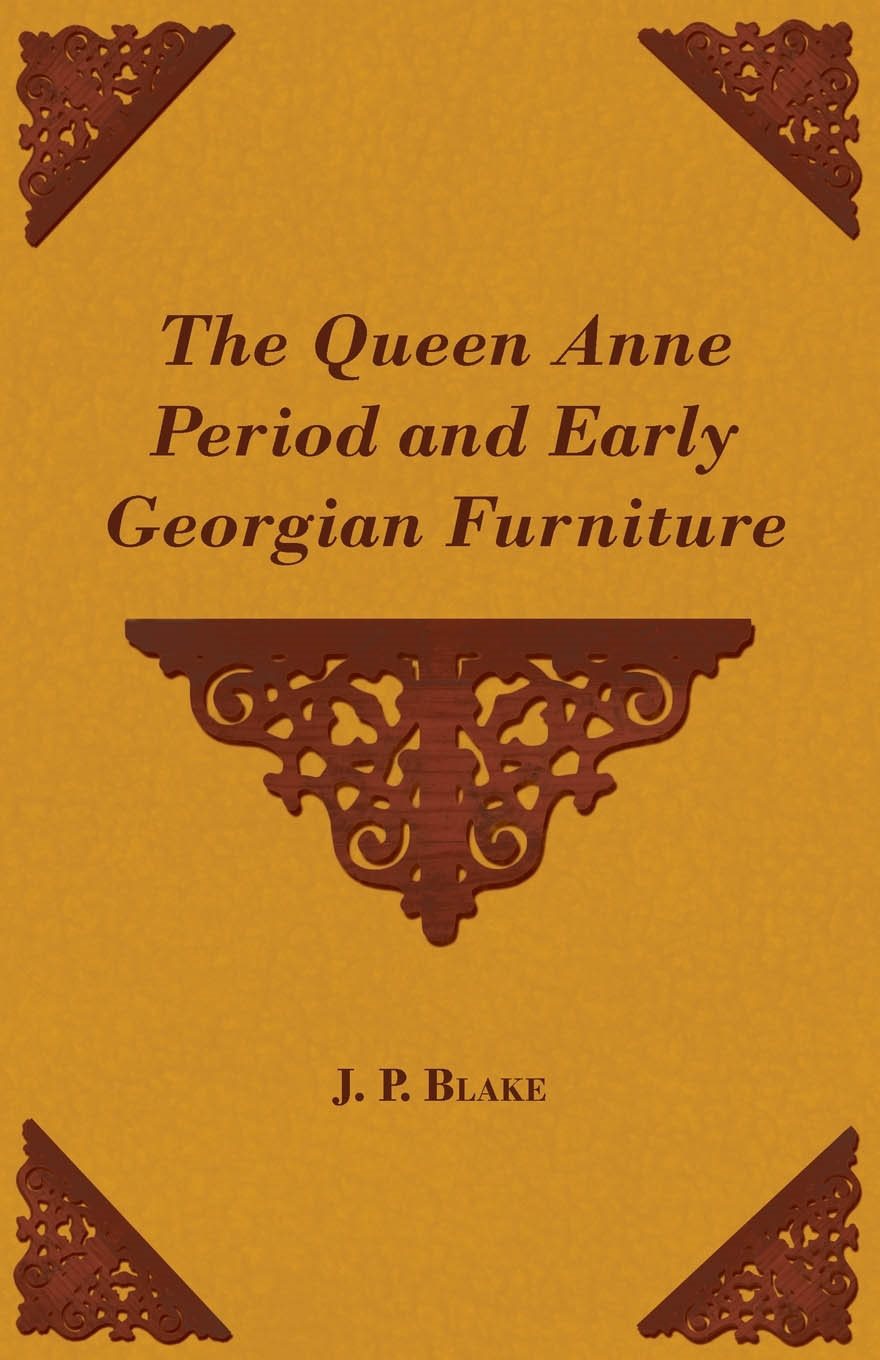The Queen Anne Period and Early Georgian Furniture
By
J. P. Blake
Copyright 2011 Read Books Ltd.
This book is copyright and may not be
reproduced or copied in any way without
the express permission of the publisher in writing
British Library Cataloguing-in-Publication Data
A catalogue record for this book is available from
the British Library
CONTENTS
A History of Furniture
Furniture is the mass noun for the movable objects intended to support various human activities, such as seating, storing, working and sleeping. Most often, at least in the present day - furniture is the product of a lengthy design process and considered a form of decorative art. In addition to furnitures functional role, it can also serve a symbolic or religious purpose, for instance in churches, temples or shrines. It can be made from many materials, including metal, plastic, and wood - using a variety of techniques, joins and decoration, reflecting the local culture from which it originated.
Furniture has been a part of the human experience since the development of non-nomadic cultures, and even before this in its crudest form. Evidence of furniture survives from the Neolithic Period and later in antiquity in the form of paintings, such as the wall Murals discovered at Pompeii; sculpture, and examples have been excavated in Egypt and found in tombs in Ghiordes, in modern-day Turkey. Perhaps one of the most interesting archaeological sites is Skara Brae, a Neolithic village located in Orkney (an archipelago in northern Scotland). The site dates from 31002500 BC and due to a shortage of wood in Orkney, the people of Skara Brae were forced to build with stone, a readily available material that could be worked easily and turned into household items. Each house shows a high degree of sophistication and was equipped with an extensive assortment of stone furniture, ranging from cupboards, dressers and beds to shelves, stone seats, and limpet tanks. The stone dresser was regarded as the most important item, as it symbolically faced the entrance in each house and was therefore the first item seen when entering.
The furniture of the Middle Ages was usually heavy, oak, and ornamented with carved designs. Along with the other arts, the Italian Renaissance of the fourteenth and fifteenth century marked a rebirth in design, often inspired by the Greco-Roman tradition. A similar explosion of design, and renaissance of culture in general, occurred in Northern Europe, starting in the fifteenth century. The seventeenth century, in both Southern and Northern Europe, was characterized by opulent, often gilded Baroque designs that frequently incorporated a profusion of vegetal and scrolling ornament. Starting in the eighteenth century, furniture designs began to develop more rapidly. Although there were some styles that belonged primarily to one nation, such as 'Palladianism' in Great Britain (derived from and inspired by the designs of the Venetian architect Andrea Palladio) or 'Louis Quinze' in French furniture (characterised by supreme craftsmanship and the integration of the arts of cabinet-making, painting, and sculpture), others, such as 'Rococo' and 'Neoclassicism' were perpetuated throughout Western Europe.
The nineteenth century is usually defined by concurrent revival styles, including Gothic, Neoclassicism, and Roccoco. The design reforms of the late century introduced the 'Aesthetic movement' (essentially promoting the beauty of objects above any other social or political themes) and the 'Arts and Crafts movement' (An international design movement that flourished between 1860-1910, led by William Morris. It stood for traditional craftsmanship using simple form, often applying medieval, romantic or folk styles of decoration). Art Nouveau, in turn was influenced by both of these movements. This latter development was perhaps the most influential of all, inspired by natural forms and structures; evident primarily in architecture, but also the beautiful objects crafted to fill such spaces. Noted furniture designers in this style included William H. Bradley; the 'Dean of American Designers', Goerges de Feure, the Parisian designer who famously produced the theatre designs for Le Chat Noir cabaret, and Hermann Obrist, a German sculptor of the Jugendstil (the German branch of Art Nouveaux) movement.
The first three-quarters of the twentieth century are often seen as the march towards Modernism in furniture design. Modernism, in general, includes the activities and creations of those who felt traditional forms of art, architecture, literature, religious faith and social activities were becoming outdated in the new economic, social, and political environment of an emergent industrialized world. Art Deco, De Stijl, Bauhaus, Wiener Werksttte, and Vienna Secession designers all worked to some degree within the Modernist idiom. Born from the Bauhaus and Art Deco/Streamline styles came the post WWII 'Mid-Century Modern' style using materials developed during the war including laminated plywood, plastics and fibreglass. Prime examples include furniture designed by George Nelson Associates, Charles and Ray Eames, Paul McCobb and Danish modern designers including Finn Juhl and Arne Jacobsen. Post-modern design, intersecting the Pop art movement, gained steam in the 1960s and 70s, promoted in the 1980s by groups such as the Italy-based Memphis movement. The latter group worked with ephemeral designs, featuring colourful decoration and asymmetrical shapes.
As is evident from this short history, the history of artistic developments is inextricably linked with the progression of furniture design. This is hardly surprising, as after all, many artists, thinkers and designers would stringently resist any artificial separation between traditional fine art and functional design. Both respond to their wider context and environment, both, perhaps in differing ways, seeking to impact on reality and society.
Today, British professional furniture makers have self organised into a strong and vibrant community, largely under the organisation 'The Worshipful Company of Furniture Makers', commonly referred to as the Furniture Makers or the Furniture Makers Company. Its motto is 'Straight and Strong'! Members of the Company come from many professions and disciplines, but the common link is that all members on joining must be engaged in or with the UK furnishing industry. Thus the work of the Company is delivered by members with wide ranging professional knowledge and skills in manufacturing, retailing, education, journalism; in fact any aspect of the industry. There are many similar organisations across the globe, as well as in the UK, all seeking to integrate and promote the valuable art that is furniture making. Education is a key factor in such endeavours, and maintaining strong links between professional practitioners, didactic colleges and the amateur maker/restorer is crucial. We hope the reader enjoys this book.

QUEEN ANNE AND EARLY GEORGIAN FURNITURE
WITHOUT suggesting that the furniture of a period ranks as an index of the development of a nation, it certainly reflects the fashions and temper of the times. Life is made up of little things, and it is pleasant to look upon our old chairs and tables and to think that they are expressive of the national feelings. Thus, this piece suggests rigid Puritanism, this the gaiety of the nation in the restoration of the Stuarts, and this one, again, the swing of the pendulum back to sobriety with the advent of the Orange rgime. As a matter of fact, on close examination, we find that the changes in furniture conventions were not always so rapid or clear cut as they might appear to have been at first sight. English designers and craftsmen never worked in watertight compartments; new influences were always creeping or boldly walking in, and England was ever absorbent of foreign ideas in the arts and crafts. With some truth, Art has been described as intelligent plagiarism. We certainly see this in the development of English furniture. Over and over again from Tudor days we see how English artificers were absorbing French, Italian, Spanish and Dutch ideas in form and decoration. In the furniture of the Stuart period and more particularly in the chairs, we see these influences, direct or transmitted. Moreover, we find that, however fanciful the motif might be, it was soon translated into English and the evolution proceeded on English lines. It is remarkable that with so mixed a parentage there should emerge a furniture so unmistakably native in its feeling.




